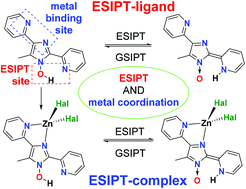В журнале Dalton Transactions (IF 4,39) опубликована статья с участием сотрудников Института Е.Б. Николаенковой (нс ЛГетс) и д.х.н.А.Я. Тихонова (гнс ЛГетс):
N-Hydroxy–N-oxide photoinduced tautomerization and excitation wavelength dependent luminescence of ESIPT-capable zinc(ii) complexes with a rationally designed 1-hydroxy-2,4-di(pyridin-2-yl)-1H-imidazole ESIPT-ligand
Nikita A. Shekhovtsov, Katerina A. Vinogradova, Sofia N. Vorobyova, Alexey S. Berezin, Victor F. Plyusnin, Dmitry Yu. Naumov, Natalia V. Pervukhina, Elena B. Nikolaenkova, Alexsei Ya. Tikhonov and Mark B. BushuevDalton Trans., 2022, V. 51, N 25, Pp. 9818-9835,
First published on 01 Jun 2022

Abstract
The ability of 1-hydroxy-1H-imidazoles to undergo proton transfer processes and to exist in N-hydroxy and N-oxide tautomeric forms can be used in coordination chemistry for the design of ESIPT-capable complexes. A series of ESIPT-capable zinc(II) complexes [Zn(HL)Hal2] (Hal = Cl, Br, I) with a rationally designed ESIPT-ligand 1-hydroxy-5-methyl-2,4-di(pyridin-2-yl)-1H-imidazole (HL) featuring spatially separated metal binding and ESIPT sites have been synthesized and characterized. Crystals of these compounds consist of a mixture of two isomers of [Zn(HL)Hal2]. Only a major isomer has a short intramolecular hydrogen bond O–H⋯N as a pre-requisite for ESIPT. In the solid state, the complexes [Zn(HL)Hal2] demonstrate temperature- and excitation wavelength dependent fluorescence in the cyan region due to the interplay of two intraligand fluorescence channels with excited state lifetimes spanning from 0.2 to 4.3 ns. The coordination of HL by Zn2+ ions results in an increase in the photoluminescence efficiency, and the photoluminescence quantum yields (PLQYs) of the complexes reach 12% at λex = 300 nm and 27% at λex = 400 nm in comparison with the PLQY of free HL of ca. 2%. Quantum chemical calculations indicate that N-hydroxy–N-oxide phototautomerization is both thermodynamically and kinetically favourable in the S1 state for [Zn(HL)Hal2]. The proton transfer induces considerable geometrical reorganizations and therefore results in large Stokes shifts of ca. 230 nm. In contrast, auxiliary ESIPT-incapable complexes [ZnL2][Zn(OAc)2]2·2H2O and [ZnL2][ZnCl2]2·4H2O with the deprotonated ligand exhibit excitation wavelength independent emission in the violet region with the Stokes shift reduced to ca. 130 nm.
Альметрики:


